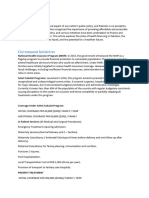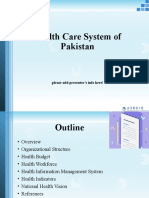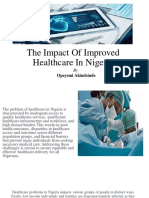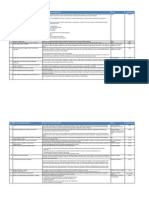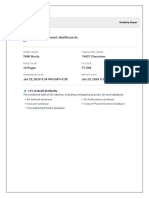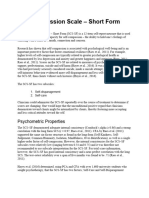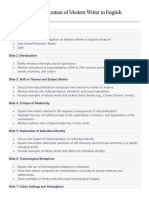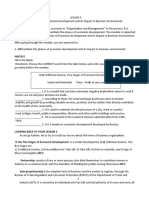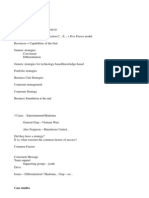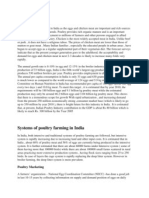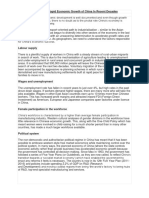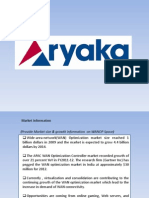0 ratings0% found this document useful (0 votes)
35 views32 pagesAssignment No.2 Course Code 9367
The document discusses strategies to improve access to healthcare in Pakistan, focusing on infrastructure, human resources, financial accessibility, disease prevention, and socio-cultural barriers. It outlines various initiatives such as expanding healthcare facilities, enhancing training for healthcare professionals, and implementing health insurance schemes to address these challenges. Additionally, it emphasizes the importance of technology, governance, and international collaboration in achieving universal healthcare coverage and improving overall health outcomes.
Uploaded by
dkhan73Copyright
© © All Rights Reserved
We take content rights seriously. If you suspect this is your content, claim it here.
Available Formats
Download as PDF, TXT or read online on Scribd
0 ratings0% found this document useful (0 votes)
35 views32 pagesAssignment No.2 Course Code 9367
The document discusses strategies to improve access to healthcare in Pakistan, focusing on infrastructure, human resources, financial accessibility, disease prevention, and socio-cultural barriers. It outlines various initiatives such as expanding healthcare facilities, enhancing training for healthcare professionals, and implementing health insurance schemes to address these challenges. Additionally, it emphasizes the importance of technology, governance, and international collaboration in achieving universal healthcare coverage and improving overall health outcomes.
Uploaded by
dkhan73Copyright
© © All Rights Reserved
We take content rights seriously. If you suspect this is your content, claim it here.
Available Formats
Download as PDF, TXT or read online on Scribd
You are on page 1/ 32
Allama Iqbal Open University
Assignment No: 02
Student Name: Hubaiba Saleem
Student I’d: 0000471209
Program: BS Pak Studies (2.5) Years
Course Name: Economic Development in
Pakistan -1
Course Code: 9367
Tutor: Miss Hajra Anwar
Semester: 4th
Q1: What are the strategies being implemented to improve access to healthcare in
Pakistan?
Improving access to healthcare in Pakistan is a multifaceted challenge that requires
comprehensive strategies addressing infrastructure, human resources, financial constraints, and
socio-cultural barriers. Pakistan, with a population exceeding 220 million, faces significant
healthcare disparities, particularly in rural and underserved areas. The government, non-
governmental organizations (NGOs), and international agencies have been working to implement
various strategies to enhance healthcare access. Below is a detailed discussion of these strategies,
categorized into key areas:
1. Strengthening Healthcare Infrastructure
A robust healthcare infrastructure is essential for improving access to healthcare services.
Pakistan has been working on the following initiatives:
a. Expansion of Healthcare Facilities
• Primary Healthcare Centers (PHCs): The government has focused on establishing and
upgrading PHCs, especially in rural areas, to provide basic healthcare services such as
immunizations, maternal and child health services, and treatment for common illnesses.
• Tertiary Care Hospitals: Efforts are being made to expand and equip tertiary care
hospitals in urban centers to handle complex medical cases, reducing the need for patients
to seek treatment abroad.
• Mobile Health Units: Mobile clinics are being deployed in remote and underserved
areas to provide essential healthcare services, including diagnostics and treatment.
b. Upgrading Existing Facilities
• Many existing healthcare facilities are being renovated and equipped with modern
medical equipment to improve service delivery.
• The government has initiated programs to ensure the availability of essential medicines
and supplies in public healthcare facilities.
c. Telemedicine and Digital Health
• Telemedicine platforms are being introduced to connect patients in remote areas with
specialists in urban centers.
• Digital health initiatives, such as electronic health records (EHRs) and health information
systems, are being implemented to streamline healthcare delivery and improve patient
outcomes.
2. Human Resource Development
A shortage of skilled healthcare professionals is a significant barrier to healthcare access in
Pakistan. Strategies to address this include:
a. Training and Education
• Increasing the number of medical and nursing schools to produce more healthcare
professionals.
• Offering scholarships and incentives for students to pursue careers in medicine, nursing,
and allied health fields.
• Providing continuous professional development programs for healthcare workers to
enhance their skills and knowledge.
b. Retention of Healthcare Workers
• Improving working conditions and offering competitive salaries to retain healthcare
professionals in public sector facilities.
• Implementing rural posting incentives, such as housing allowances and career
advancement opportunities, to encourage healthcare workers to serve in underserved
areas.
c. Community Health Workers
• Training and deploying community health workers (CHWs), such as Lady Health
Workers (LHWs), to provide basic healthcare services at the community level.
• Expanding the role of LHWs to include health education, family planning, and disease
prevention.
3. Financial Accessibility
High out-of-pocket healthcare expenses are a major barrier for many Pakistanis. Strategies to
improve financial accessibility include:
a. Health Insurance Schemes
• The government has launched health insurance programs, such as the Sehat Sahulat
Program, which provides free healthcare services to low-income families.
• Expanding health insurance coverage to include more beneficiaries and a wider range of
services.
b. Subsidized Healthcare Services
• Providing free or subsidized healthcare services in public hospitals, particularly for
essential services like maternal and child health, vaccinations, and treatment of infectious
diseases.
• Partnering with NGOs and international organizations to offer free medical camps and
diagnostic services.
c. Public-Private Partnerships (PPPs)
• Collaborating with private sector organizations to improve healthcare service delivery
and reduce costs.
• Leveraging private sector expertise and resources to expand healthcare access,
particularly in urban areas.
4. Disease Prevention and Health Promotion
Preventive healthcare is critical to reducing the burden of disease and improving overall health
outcomes. Key strategies include:
a. Immunization Programs
• Expanding immunization coverage to protect children from preventable diseases such as
polio, measles, and hepatitis.
• Conducting nationwide vaccination campaigns, particularly in high-risk areas.
b. Health Education and Awareness
• Launching public health campaigns to raise awareness about hygiene, nutrition, family
planning, and disease prevention.
• Using mass media, social media, and community outreach programs to disseminate
health information.
c. Maternal and Child Health Initiatives
• Strengthening maternal and child health services to reduce maternal and infant mortality
rates.
• Providing antenatal and postnatal care, skilled birth attendance, and neonatal care
services.
d. Control of Infectious Diseases
• Implementing programs to control the spread of infectious diseases such as tuberculosis,
malaria, and HIV/AIDS.
• Strengthening disease surveillance and response systems to detect and contain outbreaks.
5. Addressing Socio-Cultural Barriers
Socio-cultural factors, such as gender inequality and traditional beliefs, can hinder access to
healthcare. Strategies to address these barriers include:
a. Gender-Sensitive Healthcare Services
• Establishing separate healthcare facilities or designated hours for women to ensure their
privacy and comfort.
• Training healthcare providers to address the specific needs of women and girls.
b. Community Engagement
• Involving community leaders and influencers in health promotion activities to build trust
and encourage the adoption of healthy behaviors.
• Addressing cultural taboos and misconceptions about healthcare through targeted
education and outreach.
c. Empowering Women
• Promoting female education and economic empowerment to improve women's access to
healthcare.
• Encouraging women to seek healthcare services for themselves and their families.
6. Leveraging Technology and Innovation
Technology plays a crucial role in improving healthcare access. Key initiatives include:
a. Health Information Systems
• Implementing digital health information systems to improve data collection, analysis, and
decision-making.
• Using data to identify gaps in healthcare access and target interventions effectively.
b. Mobile Health (mHealth)
• Developing mobile health applications to provide health information, reminders, and
consultations.
• Using SMS-based campaigns to promote health awareness and encourage preventive
care.
c. Artificial Intelligence (AI) and Machine Learning
• Leveraging AI to improve diagnostics, predict disease outbreaks, and optimize resource
allocation.
• Using machine learning algorithms to analyze health data and identify trends.
7. Strengthening Governance and Policy Frameworks
Effective governance and policy frameworks are essential for sustainable healthcare
improvements. Key strategies include:
a. Health Sector Reforms
• Implementing reforms to improve the efficiency and accountability of the healthcare
system.
• Decentralizing healthcare management to empower provincial and local governments.
b. Regulatory Frameworks
• Strengthening regulatory frameworks to ensure the quality and safety of healthcare
services.
• Regulating the private healthcare sector to prevent exploitation and ensure affordability.
c. Monitoring and Evaluation
• Establishing robust monitoring and evaluation systems to track progress and identify
areas for improvement.
• Using evidence-based approaches to inform policy decisions and resource allocation.
8. International Collaboration and Support
Pakistan has been collaborating with international organizations and donor agencies to improve
healthcare access. Key initiatives include:
a. Funding and Technical Assistance
• Receiving financial and technical support from organizations such as the World Health
Organization (WHO), UNICEF, and the Global Fund to strengthen healthcare systems.
• Partnering with international NGOs to implement healthcare projects and programs.
b. Knowledge Sharing and Capacity Building
• Participating in global health initiatives and sharing best practices with other countries.
• Building the capacity of healthcare professionals through international training programs
and exchanges.
9. Focus on Vulnerable Populations
Ensuring equitable access to healthcare for vulnerable populations is a priority. Strategies
include:
a. Refugee and Displaced Populations
• Providing healthcare services to refugees and internally displaced persons (IDPs) through
camps and mobile clinics.
• Collaborating with international organizations to address the health needs of these
populations.
b. People with Disabilities
• Ensuring that healthcare facilities are accessible to people with disabilities.
• Providing specialized healthcare services and rehabilitation programs.
c. Elderly Population
• Developing geriatric care services to address the health needs of the elderly.
• Promoting healthy aging through preventive healthcare and social support programs.
10. Climate Change and Health
Climate change poses significant challenges to healthcare access in Pakistan. Strategies to
address this include:
a. Disaster Preparedness
• Strengthening healthcare systems to respond to climate-related disasters such as floods
and heatwaves.
• Establishing emergency response teams and stockpiling essential medical supplies.
b. Environmental Health Initiatives
• Implementing programs to address environmental health issues such as air and water
pollution.
• Promoting sustainable practices to mitigate the impact of climate change on health.
Conclusion
Improving access to healthcare in Pakistan is a complex and ongoing process that requires
coordinated efforts from the government, private sector, civil society, and international partners.
While significant progress has been made, challenges such as inadequate infrastructure, financial
constraints, and socio-cultural barriers persist. By continuing to implement and scale up these
strategies, Pakistan can move closer to achieving universal health coverage and ensuring that all
citizens have access to quality healthcare services. The success of these efforts will depend on
sustained political commitment, adequate funding, and the active participation of all
stakeholders.
Q2: Discuss the role of infrastructure in economic growth. How can Pakistan improve its
infrastructure to facilitate economic growth?
Infrastructure plays a pivotal role in economic growth, serving as the backbone of a nation's
development. It encompasses the physical and organizational structures needed for the
functioning of a society, including transportation networks, energy systems, communication
technologies, water supply, and sanitation facilities. For Pakistan, a country with immense
potential but facing significant developmental challenges, improving infrastructure is critical to
unlocking economic growth, reducing poverty, and enhancing the quality of life for its citizens.
This essay explores the role of infrastructure in economic growth and provides a comprehensive
analysis of how Pakistan can improve its infrastructure to facilitate sustainable development.
The Role of Infrastructure in Economic Growth
Infrastructure is a key driver of economic growth, as it directly and indirectly influences
productivity, investment, and overall economic activity. Below are the primary ways in which
infrastructure contributes to economic growth:
1. Enhancing Productivity
• Infrastructure reduces the cost of production and transportation, enabling businesses to
operate more efficiently.
• Reliable energy and transportation networks allow industries to function without
interruptions, boosting output and competitiveness.
2. Attracting Investment
• Quality infrastructure is a prerequisite for attracting foreign and domestic investment.
Investors seek locations with reliable utilities, transportation, and communication
systems.
• Industrial zones and special economic zones (SEZs) with robust infrastructure are more
likely to attract businesses, creating jobs and stimulating economic activity.
3. Facilitating Trade
• Efficient transportation networks, such as roads, railways, and ports, reduce the cost and
time of moving goods, both domestically and internationally.
• Improved trade infrastructure enhances a country's integration into global markets,
increasing exports and foreign exchange earnings.
4. Improving Access to Markets
• Infrastructure connects rural and urban areas, enabling farmers and small businesses to
access larger markets and sell their products at competitive prices.
• Better connectivity also reduces regional disparities, promoting inclusive growth.
5. Enhancing Human Capital Development
• Infrastructure such as schools, hospitals, and clean water supply systems improves access
to education and healthcare, leading to a healthier and more skilled workforce.
• A well-educated and healthy population is more productive and contributes to long-term
economic growth.
6. Promoting Innovation and Technology
• Advanced communication and technology infrastructure, such as broadband internet,
fosters innovation and the adoption of new technologies.
• Digital infrastructure enables the growth of knowledge-based industries, such as IT and
e-commerce.
7. Reducing Poverty
• Infrastructure development creates jobs during construction and operation, providing
income opportunities for the poor.
• Access to basic services, such as clean water and sanitation, improves living standards
and reduces poverty.
8. Supporting Urbanization
• As populations grow and urbanize, infrastructure such as housing, transportation, and
utilities becomes essential to accommodate the increasing demand.
• Well-planned urban infrastructure prevents overcrowding, pollution, and other urban
challenges.
9. Ensuring Environmental Sustainability
• Sustainable infrastructure, such as renewable energy systems and efficient public
transportation, reduces environmental degradation and supports long-term economic
growth.
• Green infrastructure projects can also create new industries and jobs in the renewable
energy sector.
Challenges to Infrastructure Development in Pakistan
Despite its importance, Pakistan faces significant challenges in developing its infrastructure.
These challenges include:
1. Insufficient Funding
• Limited public resources and budget constraints hinder infrastructure development.
• The government often prioritizes short-term needs over long-term infrastructure projects.
2. Poor Maintenance
• Existing infrastructure is often poorly maintained, leading to rapid deterioration and
inefficiencies.
• Lack of maintenance increases the long-term cost of infrastructure projects.
3. Political Instability
• Frequent changes in government and political instability disrupt long-term infrastructure
planning and implementation.
• Corruption and mismanagement further exacerbate the problem.
4. Regional Disparities
• Infrastructure development is concentrated in urban areas, while rural regions remain
underserved.
• This disparity limits economic opportunities in rural areas and contributes to migration to
cities.
5. Energy Shortages
• Chronic energy shortages, including electricity and gas, hinder industrial and commercial
activities.
• Inefficient energy infrastructure increases costs for businesses and households.
6. Climate Change
• Pakistan is highly vulnerable to climate change, with frequent floods, droughts, and
extreme weather events damaging infrastructure.
• Climate resilience is often overlooked in infrastructure planning.
7. Bureaucratic Hurdles
• Complex regulatory processes and red tape delay infrastructure projects and increase
costs.
• Lack of coordination among government agencies further complicates implementation.
Strategies to Improve Infrastructure in Pakistan
To address these challenges and harness the potential of infrastructure for economic growth,
Pakistan must adopt a comprehensive and strategic approach. Below are key strategies for
improving infrastructure in the country:
1. Increasing Investment in Infrastructure
• Public Investment: The government should allocate a larger portion of its budget to
infrastructure development, prioritizing projects with high economic returns.
• Private Sector Participation: Encouraging public-private partnerships (PPPs) can
mobilize private sector resources and expertise for infrastructure projects.
• International Funding: Leveraging loans and grants from international financial
institutions, such as the World Bank and Asian Development Bank, can supplement
domestic funding.
2. Improving Energy Infrastructure
• Renewable Energy: Investing in renewable energy sources, such as solar, wind, and
hydropower, can address energy shortages and reduce reliance on fossil fuels.
• Energy Efficiency: Upgrading existing energy infrastructure to reduce losses and
improve efficiency.
• Diversification: Diversifying energy sources to ensure a stable and reliable energy
supply.
3. Developing Transportation Networks
• Roads and Highways: Expanding and upgrading the road network to improve
connectivity between urban and rural areas.
• Railways: Modernizing the railway system to enhance freight and passenger transport.
• Ports and Airports: Developing ports and airports to facilitate trade and tourism.
4. Enhancing Digital Infrastructure
• Broadband Internet: Expanding broadband internet access to rural and underserved
areas.
• E-Government: Implementing e-government services to improve public service delivery
and reduce corruption.
• Digital Literacy: Promoting digital literacy to enable citizens to benefit from digital
infrastructure.
5. Promoting Sustainable Urban Development
• Affordable Housing: Developing affordable housing projects to accommodate urban
population growth.
• Public Transportation: Investing in efficient and sustainable public transportation
systems to reduce traffic congestion and pollution.
• Smart Cities: Implementing smart city initiatives to improve urban planning and
resource management.
6. Strengthening Water and Sanitation Infrastructure
• Water Management: Developing infrastructure for water storage, distribution, and
treatment to address water scarcity.
• Sanitation: Expanding access to clean water and sanitation facilities to improve public
health.
7. Building Climate-Resilient Infrastructure
• Flood Protection: Constructing dams, levees, and drainage systems to protect against
floods.
• Disaster Preparedness: Developing infrastructure for disaster response and recovery.
• Sustainable Practices: Incorporating climate resilience into infrastructure planning and
design.
8. Improving Governance and Coordination
• Streamlining Regulations: Simplifying regulatory processes to accelerate infrastructure
projects.
• Anti-Corruption Measures: Implementing measures to reduce corruption and ensure
transparency in infrastructure projects.
• Inter-Agency Coordination: Enhancing coordination among government agencies to
improve project implementation.
9. Focusing on Rural Development
• Rural Connectivity: Expanding infrastructure in rural areas to improve access to
markets, education, and healthcare.
• Agricultural Infrastructure: Developing infrastructure for irrigation, storage, and
transportation of agricultural products to boost rural economies.
10. Leveraging Technology and Innovation
• Smart Infrastructure: Using technology to monitor and maintain infrastructure, such as
smart grids and intelligent transportation systems.
• Innovative Financing: Exploring innovative financing mechanisms, such as green bonds
and crowdfunding, for infrastructure projects.
Case Studies of Successful Infrastructure Development
1. China-Pakistan Economic Corridor (CPEC)
• CPEC is a flagship infrastructure project that aims to connect Gwadar Port in Pakistan to
China's northwestern region through a network of roads, railways, and pipelines.
• The project has already improved transportation and energy infrastructure in Pakistan,
attracting investment and creating jobs.
2. Lahore Metro Bus System
• The Lahore Metro Bus System is a successful example of sustainable urban
transportation infrastructure.
• The project has reduced traffic congestion and improved mobility for millions of
residents.
3. Diamer-Bhasha Dam
• The Diamer-Bhasha Dam is a major hydropower project that will address energy
shortages and provide water storage for agriculture.
• The project demonstrates the potential of large-scale infrastructure investments to drive
economic growth.
Conclusion
Infrastructure is a cornerstone of economic growth, enabling productivity, trade, investment, and
human capital development. For Pakistan, improving infrastructure is essential to overcoming
developmental challenges and achieving sustainable economic growth. By increasing
investment, leveraging technology, promoting sustainability, and improving governance,
Pakistan can build the infrastructure needed to unlock its economic potential. The success of
these efforts will depend on political will, effective implementation, and the active participation
of all stakeholders. With a strategic and coordinated approach, Pakistan can transform its
infrastructure landscape and pave the way for a prosperous future.
Q3: What are the challenges and opportunities for developing the tourism industry in
Pakistan?
The tourism industry in Pakistan holds immense potential to become a significant driver of
economic growth, job creation, and cultural exchange. With its diverse landscapes, rich cultural
heritage, and historical significance, Pakistan is a treasure trove for tourists. However, despite its
potential, the country faces numerous challenges in developing its tourism sector. At the same
time, there are significant opportunities that, if leveraged effectively, can transform Pakistan into
a global tourism destination. This essay explores the challenges and opportunities for developing
the tourism industry in Pakistan, providing a comprehensive analysis of the current landscape
and future prospects.
Challenges to Developing the Tourism Industry in Pakistan
1. Security Concerns
• Terrorism and Instability: Pakistan has faced security challenges due to terrorism and
political instability, which have deterred international tourists.
• Perception Issues: Negative media coverage and travel advisories from foreign
governments have contributed to a perception of Pakistan as an unsafe destination.
2. Inadequate Infrastructure
• Transportation: Poor road networks, limited air connectivity, and inadequate public
transportation make it difficult for tourists to access remote areas.
• Accommodation: A lack of quality hotels and guesthouses, particularly in rural and
mountainous regions, limits the capacity to accommodate tourists.
• Basic Facilities: Insufficient access to clean water, sanitation, and healthcare facilities in
tourist areas affects the overall visitor experience.
3. Limited Marketing and Promotion
• Weak Branding: Pakistan has not effectively marketed itself as a tourist destination on
the global stage.
• Digital Presence: The country’s tourism websites and online platforms are often
outdated and lack comprehensive information for potential visitors.
4. Regulatory and Bureaucratic Hurdles
• Visa Restrictions: Complex and restrictive visa policies discourage international tourists
from visiting Pakistan.
• Lack of Coordination: Poor coordination among government agencies and stakeholders
hinders the development of a cohesive tourism strategy.
5. Environmental Degradation
• Pollution: Littering and pollution in tourist areas, such as northern regions, damage the
natural beauty and deter visitors.
• Over-Tourism: Unregulated tourism in fragile ecosystems, such as the northern
mountains, leads to environmental degradation.
6. Seasonal Tourism
• Limited Year-Round Appeal: Tourism in Pakistan is highly seasonal, with most visitors
arriving during the summer months. This results in underutilization of resources during
the off-season.
7. Lack of Skilled Workforce
• Training Gaps: The tourism industry lacks trained professionals, including tour guides,
hospitality staff, and travel agents.
• Language Barriers: Limited proficiency in foreign languages among service providers
affects communication with international tourists.
8. Cultural and Social Barriers
• Conservative Norms: Cultural restrictions, particularly for female tourists, can create
discomfort and limit the appeal of Pakistan as a destination.
• Misinformation: Misconceptions about Pakistan’s culture and society often deter
potential visitors.
9. Economic Constraints
• Limited Investment: Insufficient public and private investment in tourism infrastructure
and promotion restricts the sector’s growth.
• High Costs: The cost of travel and accommodation in Pakistan is relatively high
compared to competing destinations in the region.
10. Impact of Climate Change
• Natural Disasters: Pakistan is vulnerable to climate change, with frequent floods,
earthquakes, and landslides disrupting tourism activities.
• Glacial Melting: The melting of glaciers in the northern regions threatens the
sustainability of tourism in these areas.
Opportunities for Developing the Tourism Industry in Pakistan
Despite these challenges, Pakistan has numerous opportunities to develop its tourism industry.
Below are the key opportunities:
1. Diverse Tourist Attractions
• Natural Beauty: Pakistan is home to some of the world’s most stunning landscapes,
including the Himalayan and Karakoram mountain ranges, pristine lakes, and deserts.
• Cultural Heritage: The country boasts a rich cultural heritage, with ancient
archaeological sites such as Mohenjo-Daro, Taxila, and the Mughal-era monuments in
Lahore.
• Religious Tourism: Pakistan has significant religious sites for Muslims, Hindus, Sikhs,
and Buddhists, attracting pilgrims from around the world.
2. Adventure Tourism
• Mountaineering and Trekking: The northern regions, including K2 and Nanga Parbat,
offer world-class opportunities for mountaineering and trekking.
• Eco-Tourism: Pakistan’s diverse ecosystems, such as its national parks and wildlife
reserves, provide opportunities for eco-tourism.
3. Improved Security Situation
• Decline in Terrorism: The security situation in Pakistan has improved significantly in
recent years, creating a more favorable environment for tourism.
• Positive Media Coverage: Increased positive media coverage and endorsements from
international travel influencers have boosted Pakistan’s image as a tourist destination.
4. Government Initiatives
• Tourism-Friendly Policies: The government has introduced initiatives such as e-visas
and visa-on-arrival for tourists from select countries.
• Infrastructure Development: Projects like the China-Pakistan Economic Corridor
(CPEC) are improving transportation infrastructure, making tourist destinations more
accessible.
5. Digital Transformation
• Online Marketing: Leveraging social media and digital platforms to promote Pakistan’s
tourism potential can attract a global audience.
• Travel Apps: Developing travel apps and online booking platforms can enhance the
convenience and accessibility of tourism services.
6. Cultural and Festive Tourism
• Cultural Festivals: Promoting cultural festivals, such as the Shandur Polo Festival and
Lok Virsa Mela, can attract tourists interested in local traditions.
• Culinary Tourism: Highlighting Pakistan’s diverse cuisine can appeal to food
enthusiasts.
7. Community-Based Tourism
• Local Involvement: Involving local communities in tourism activities can create
economic opportunities and preserve cultural heritage.
• Homestays: Promoting homestays in rural areas can provide authentic experiences for
tourists while benefiting local residents.
8. Medical and Wellness Tourism
• Affordable Healthcare: Pakistan’s relatively low-cost healthcare services can attract
medical tourists.
• Wellness Retreats: Developing wellness retreats in scenic locations can appeal to
tourists seeking relaxation and rejuvenation.
9. Educational Tourism
• Historical Sites: Promoting Pakistan’s historical and archaeological sites can attract
students and researchers.
• Cultural Exchange: Encouraging cultural exchange programs can foster international
understanding and tourism.
10. Sustainable Tourism
• Eco-Friendly Practices: Adopting sustainable tourism practices can preserve natural
resources and attract environmentally conscious travelers.
• Conservation Projects: Investing in conservation projects, such as wildlife protection
and reforestation, can enhance the appeal of eco-tourism.
Strategies to Overcome Challenges and Leverage Opportunities
To develop the tourism industry in Pakistan, a comprehensive and strategic approach is required.
Below are key strategies:
1. Enhancing Security and Perception
• Security Measures: Strengthening security in tourist areas and ensuring the safety of
visitors.
• Positive Branding: Launching international marketing campaigns to rebrand Pakistan as
a safe and attractive destination.
2. Improving Infrastructure
• Transportation: Upgrading road networks, airports, and public transportation to
improve accessibility.
• Accommodation: Encouraging investment in hotels, resorts, and guesthouses,
particularly in remote areas.
3. Streamlining Visa Policies
• E-Visas: Expanding the e-visa facility to more countries and simplifying the application
process.
• Visa-Free Entry: Offering visa-free entry to tourists from select countries to boost
arrivals.
4. Promoting Sustainable Tourism
• Regulations: Implementing regulations to prevent over-tourism and environmental
degradation.
• Awareness Campaigns: Educating tourists and local communities about sustainable
tourism practices.
5. Capacity Building
• Training Programs: Providing training for tourism professionals to improve service
quality.
• Language Skills: Offering language courses to enhance communication with
international tourists.
6. Public-Private Partnerships
• Collaboration: Encouraging collaboration between the government and private sector to
develop tourism infrastructure and services.
• Investment Incentives: Offering incentives for private investment in the tourism sector.
7. Leveraging Technology
• Digital Platforms: Developing user-friendly websites and apps for tourism promotion
and bookings.
• Virtual Tours: Offering virtual tours of Pakistan’s attractions to attract potential visitors.
8. Community Engagement
• Local Participation: Involving local communities in tourism planning and decision-
making.
• Economic Benefits: Ensuring that tourism revenues benefit local residents.
9. Diversifying Tourism Offerings
• Year-Round Attractions: Developing attractions and activities that appeal to tourists
throughout the year.
• Niche Markets: Targeting niche markets, such as adventure, cultural, and religious
tourism.
10. Monitoring and Evaluation
• Data Collection: Collecting data on tourist arrivals, preferences, and feedback to inform
policy decisions.
• Performance Metrics: Establishing performance metrics to evaluate the effectiveness of
tourism initiatives.
Conclusion
The tourism industry in Pakistan has the potential to become a major contributor to the country’s
economic growth and development. While significant challenges exist, including security
concerns, inadequate infrastructure, and regulatory hurdles, there are also immense opportunities
to leverage Pakistan’s natural beauty, cultural heritage, and adventure tourism potential. By
adopting a strategic and inclusive approach that prioritizes security, sustainability, and
community engagement, Pakistan can transform its tourism sector into a thriving industry. With
the right policies, investments, and marketing efforts, Pakistan can position itself as a premier
global tourism destination, attracting visitors from around the world and reaping the economic
and social benefits of a vibrant tourism industry.
Q4; What are the main strategies being implemented to promote agricultural development
in Pakistan.
Agriculture is the backbone of Pakistan's economy, contributing approximately 22-24% to the
GDP and employing nearly 37.4% of the labor force. It is also a critical source of livelihood for
the majority of the rural population. However, the sector faces numerous challenges, including
water scarcity, outdated farming practices, low productivity, and climate change. To address
these issues and promote agricultural development, the government of Pakistan, along with
international organizations and private stakeholders, has implemented various strategies. This
essay provides a comprehensive analysis of the main strategies being implemented to promote
agricultural development in Pakistan, covering policy reforms, technological advancements,
infrastructure development, and sustainability initiatives.
1. Policy Reforms and Institutional Support
a. National Agricultural Policy
• The government has introduced the National Agricultural Policy to provide a
comprehensive framework for the development of the agriculture sector. The policy
focuses on improving productivity, ensuring food security, and enhancing farmers'
incomes.
• Key objectives include promoting sustainable farming practices, increasing access to
credit, and improving market access for farmers.
b. Subsidies and Incentives
• The government provides subsidies on fertilizers, seeds, and pesticides to reduce the cost
of production for farmers.
• Incentives such as tax exemptions and reduced import duties on agricultural machinery
are offered to encourage mechanization.
c. Land Reforms
• Efforts are being made to address land fragmentation and improve land tenure systems to
ensure equitable access to land resources.
• The government is also working on digitizing land records to reduce disputes and
improve transparency.
d. Research and Development (R&D)
• Institutions like the Pakistan Agricultural Research Council (PARC) and provincial
agricultural research organizations are conducting research to develop high-yield,
disease-resistant crop varieties.
• Collaboration with international research organizations, such as the International Maize
and Wheat Improvement Center (CIMMYT), is also being strengthened.
2. Technological Advancements
a. Mechanization of Agriculture
• The use of modern machinery, such as tractors, harvesters, and seed drills, is being
promoted to increase efficiency and reduce labor costs.
• The government is providing loans and subsidies to farmers for the purchase of
agricultural machinery.
b. Precision Agriculture
• Technologies such as GPS, drones, and sensors are being introduced to optimize the use
of inputs like water, fertilizers, and pesticides.
• Precision agriculture helps in monitoring crop health, soil conditions, and weather
patterns, enabling data-driven decision-making.
c. Genetically Modified (GM) Crops
• The cultivation of GM crops, such as Bt cotton, has been introduced to improve yields
and reduce pest-related losses.
• Research is ongoing to develop GM varieties of other crops, such as wheat and rice, to
enhance productivity and resilience.
d. Digital Agriculture
• Mobile apps and online platforms are being developed to provide farmers with real-time
information on weather, market prices, and best farming practices.
• Digital tools also facilitate access to credit, insurance, and extension services.
3. Water Management and Irrigation
a. Improving Irrigation Infrastructure
• The government is investing in the rehabilitation and modernization of irrigation systems,
including canals, dams, and watercourses.
• Projects like the Kachi Canal and Rainee Canal aim to bring additional land under
cultivation.
b. Drip and Sprinkler Irrigation
• Water-efficient irrigation techniques, such as drip and sprinkler systems, are being
promoted to reduce water wastage and improve crop yields.
• Subsidies and training programs are provided to farmers to adopt these technologies.
c. Water Conservation
• Awareness campaigns are being conducted to educate farmers about water conservation
practices, such as laser land leveling and mulching.
• The construction of small dams and rainwater harvesting systems is being encouraged to
store and utilize rainwater effectively.
d. Climate-Resilient Crops
• Research is being conducted to develop drought-resistant and heat-tolerant crop varieties
to address the challenges of climate change.
• Farmers are being trained to adopt climate-smart agricultural practices.
4. Access to Credit and Financial Services
a. Agricultural Loans
• The government, in collaboration with banks and microfinance institutions, is providing
low-interest loans to farmers for the purchase of inputs, machinery, and livestock.
• Special loan schemes are available for small and marginalized farmers.
b. Crop Insurance
• Crop insurance schemes are being introduced to protect farmers against losses due to
natural disasters, pests, and diseases.
• The government is working with insurance companies to make crop insurance more
accessible and affordable.
c. Digital Financial Services
• Mobile banking and digital wallets are being promoted to facilitate easy access to credit
and financial services for farmers in remote areas.
• These services also enable farmers to receive subsidies and payments directly into their
accounts.
5. Market Access and Value Addition
a. Establishment of Market Infrastructure
• The government is developing modern market infrastructure, such as cold storage
facilities, warehouses, and processing units, to reduce post-harvest losses.
• Fruit and Vegetable Markets are being established to provide farmers with better
access to buyers.
b. Export Promotion
• Efforts are being made to promote the export of high-value agricultural products, such as
fruits, vegetables, and seafood.
• The government is providing incentives, such as export subsidies and reduced tariffs, to
boost agricultural exports.
c. Value Addition and Agro-Processing
• The establishment of agro-processing industries is being encouraged to add value to raw
agricultural products and increase farmers' incomes.
• Special economic zones (SEZs) are being developed to attract investment in agro-
processing.
d. E-Commerce Platforms
• Online platforms are being developed to connect farmers directly with consumers,
eliminating middlemen and ensuring better prices for farmers.
• These platforms also provide farmers with access to a wider market.
6. Capacity Building and Extension Services
a. Farmer Training Programs
• Training programs are being conducted to educate farmers about modern farming
techniques, pest management, and sustainable practices.
• These programs are organized by government agencies, NGOs, and international
organizations.
b. Extension Services
• The government is strengthening agricultural extension services to provide farmers with
timely advice and support.
• Mobile-based extension services are being introduced to reach farmers in remote areas.
c. Women in Agriculture
• Special programs are being implemented to empower women farmers by providing them
with training, credit, and access to resources.
• Women are being encouraged to participate in decision-making processes related to
agriculture.
7. Sustainable Agriculture and Environmental Protection
a. Organic Farming
• The adoption of organic farming practices is being promoted to reduce the use of
chemical fertilizers and pesticides.
• Certification programs are being introduced to help farmers access premium markets for
organic products.
b. Soil Health Management
• Soil testing facilities are being established to help farmers assess soil health and apply
fertilizers more efficiently.
• The use of organic fertilizers, such as compost and biochar, is being encouraged.
c. Agroforestry
• Agroforestry practices, such as planting trees on farmland, are being promoted to
improve soil fertility, conserve water, and provide additional income sources.
• The government is providing subsidies for tree planting and agroforestry projects.
d. Climate-Smart Agriculture
• Farmers are being trained to adopt climate-smart practices, such as crop diversification,
conservation agriculture, and integrated pest management.
• Early warning systems are being developed to help farmers prepare for extreme weather
events.
8. Public-Private Partnerships (PPPs)
a. Collaboration with Private Sector
• The government is collaborating with private companies to invest in agricultural
infrastructure, research, and technology.
• PPPs are being used to develop agro-processing units, cold storage facilities, and market
infrastructure.
b. Corporate Farming
• Large-scale corporate farming is being encouraged to introduce modern farming practices
and increase productivity.
• The government is providing incentives, such as tax breaks and land leases, to attract
corporate investment in agriculture.
9. International Collaboration and Support
a. Foreign Aid and Grants
• Pakistan is receiving financial and technical assistance from international organizations,
such as the World Bank, Asian Development Bank (ADB), and Food and Agriculture
Organization (FAO), to support agricultural development.
• Projects funded by these organizations focus on areas such as irrigation, research, and
capacity building.
b. Knowledge Sharing
• Pakistan is collaborating with other countries to share knowledge and best practices in
agriculture.
• Exchange programs and study tours are being organized for farmers and researchers.
10. Focus on High-Value Crops
a. Horticulture Development
• The government is promoting the cultivation of high-value horticultural crops, such as
fruits, vegetables, and flowers, to increase farmers' incomes.
• Training and subsidies are provided to farmers to adopt modern horticultural practices.
b. Livestock and Dairy Development
• The livestock sector is being developed to provide additional income sources for farmers.
• Programs are being implemented to improve animal health, breeding, and feed
management.
Conclusion
Agricultural development is critical for Pakistan's economic growth, food security, and poverty
alleviation. While the sector faces numerous challenges, the strategies being implemented—
ranging from policy reforms and technological advancements to sustainable practices and
international collaboration—hold significant promise. By addressing issues such as water
scarcity, low productivity, and market access, Pakistan can unlock the full potential of its
agriculture sector. The success of these efforts will depend on effective implementation,
coordination among stakeholders, and sustained investment. With a comprehensive and inclusive
approach, Pakistan can transform its agriculture sector into a modern, productive, and sustainable
industry that benefits farmers, consumers, and the economy as a whole.
Q5: What are the potential benefits and drawbacks of pursuing free trade agreements for
Pakistan?
Free trade agreements (FTAs) have become a cornerstone of global economic policy, offering
countries the opportunity to expand their markets, enhance economic growth, and integrate into
the global economy. For Pakistan, a developing country with significant economic challenges,
pursuing FTAs presents both potential benefits and drawbacks. This essay provides a
comprehensive analysis of the potential advantages and disadvantages of free trade agreements
for Pakistan, covering economic, social, and political dimensions.
Potential Benefits of Free Trade Agreements for Pakistan
1. Economic Growth and Development
• Increased Exports: FTAs can open up new markets for Pakistani goods, particularly
textiles, agricultural products, and manufactured goods. By reducing tariffs and trade
barriers, Pakistani exporters can compete more effectively in international markets.
• Foreign Direct Investment (FDI): FTAs often include provisions that protect foreign
investors, making Pakistan a more attractive destination for FDI. Increased investment
can lead to job creation, technology transfer, and infrastructure development.
• Economic Diversification: Access to larger markets can encourage the diversification of
Pakistan's economy, reducing its reliance on a few key sectors such as textiles and
agriculture.
2. Enhanced Competitiveness
• Efficiency Gains: Exposure to international competition can drive domestic industries to
improve efficiency, adopt new technologies, and innovate. This can lead to higher
productivity and better-quality products.
• Economies of Scale: Access to larger markets allows Pakistani firms to achieve
economies of scale, reducing per-unit costs and increasing profitability.
3. Consumer Benefits
• Lower Prices: Reduced tariffs on imported goods can lead to lower prices for
consumers, increasing their purchasing power and improving living standards.
• Greater Variety: FTAs can provide consumers with access to a wider variety of goods
and services, enhancing choice and quality.
4. Strengthened Trade Relations
• Diplomatic Ties: FTAs can strengthen diplomatic and economic ties with partner
countries, fostering greater political and economic cooperation.
• Regional Integration: FTAs can facilitate regional integration, promoting peace and
stability in South Asia and beyond.
5. Access to Technology and Knowledge
• Technology Transfer: FTAs often include provisions for technology transfer and
collaboration, enabling Pakistani industries to adopt advanced technologies and improve
productivity.
• Skill Development: Exposure to international markets can lead to the development of
new skills and expertise among the workforce, enhancing human capital.
6. Improved Standards and Regulations
• Regulatory Harmonization: FTAs can lead to the harmonization of standards and
regulations, improving the quality and safety of Pakistani products and making them
more competitive in international markets.
• Intellectual Property Rights: FTAs often include provisions for the protection of
intellectual property rights, encouraging innovation and creativity.
7. Poverty Reduction
• Job Creation: Increased trade and investment can create new job opportunities,
particularly in export-oriented industries, reducing poverty and improving livelihoods.
• Income Growth: Higher incomes from trade-related activities can lead to improved
living standards and reduced income inequality.
Potential Drawbacks of Free Trade Agreements for Pakistan
1. Economic Vulnerability
• Trade Deficits: Increased imports under FTAs can lead to trade deficits if domestic
industries are unable to compete with foreign competitors. This can strain Pakistan's
foreign exchange reserves and balance of payments.
• Dependency: Over-reliance on a few trading partners can make Pakistan vulnerable to
economic shocks and changes in global market conditions.
2. Impact on Domestic Industries
• Competition: Domestic industries, particularly small and medium-sized enterprises
(SMEs), may struggle to compete with larger, more efficient foreign firms. This can lead
to business closures and job losses.
• De-Industrialization: The influx of cheaper foreign goods can lead to the decline of
domestic manufacturing, a phenomenon known as de-industrialization.
3. Agricultural Challenges
• Market Access: While FTAs can open up new markets for Pakistani agricultural
products, they can also expose local farmers to competition from highly subsidized
agricultural products from developed countries.
• Food Security: Increased reliance on food imports can undermine food security,
particularly if global prices rise or supply chains are disrupted.
4. Social and Economic Inequality
• Uneven Benefits: The benefits of FTAs may not be evenly distributed, with certain
regions and sectors benefiting more than others. This can exacerbate regional and social
inequalities.
• Labor Exploitation: Increased competition can lead to downward pressure on wages and
working conditions, particularly in labor-intensive industries.
5. Loss of Policy Autonomy
• Regulatory Constraints: FTAs often include provisions that limit the ability of
governments to implement certain policies, such as subsidies, tariffs, and regulations.
This can constrain Pakistan's ability to pursue independent economic and social policies.
• Investor-State Dispute Settlement (ISDS): ISDS provisions in FTAs can allow foreign
investors to challenge government policies in international tribunals, potentially
undermining national sovereignty.
6. Environmental Concerns
• Resource Exploitation: Increased trade and investment can lead to the over-exploitation
of natural resources, contributing to environmental degradation and loss of biodiversity.
• Pollution: The growth of export-oriented industries can lead to increased pollution and
environmental damage, particularly if environmental regulations are weak or poorly
enforced.
7. Cultural Impact
• Cultural Homogenization: Increased trade and exposure to foreign goods and services
can lead to cultural homogenization, eroding local traditions and cultural diversity.
• Consumerism: The influx of foreign goods can promote consumerism and materialism,
potentially undermining social values and community cohesion.
Case Studies of FTAs Involving Pakistan
1. Pakistan-China Free Trade Agreement (FTA)
• Benefits: The FTA has increased bilateral trade and investment, with China becoming
one of Pakistan's largest trading partners. The agreement has also facilitated infrastructure
development under the China-Pakistan Economic Corridor (CPEC).
• Drawbacks: The FTA has led to a significant trade deficit for Pakistan, with imports
from China far exceeding exports. There are also concerns about the impact on domestic
industries and the quality of Chinese goods.
2. Pakistan-Malaysia Free Trade Agreement
• Benefits: The FTA has increased trade and investment between the two countries, with
Malaysia becoming an important market for Pakistani textiles and agricultural products.
• Drawbacks: The agreement has had limited impact on overall trade volumes, and there
are concerns about the competitiveness of Pakistani products in the Malaysian market.
3. South Asian Free Trade Agreement (SAFTA)
• Benefits: SAFTA has promoted regional trade and economic integration, with Pakistan
benefiting from increased trade with neighboring countries such as India and Bangladesh.
• Drawbacks: Political tensions and non-tariff barriers have limited the effectiveness of
SAFTA, and trade volumes remain below potential.
Strategies to Maximize Benefits and Mitigate Drawbacks
1. Strengthening Domestic Industries
• Capacity Building: Invest in the development of domestic industries, particularly SMEs,
to enhance their competitiveness and ability to benefit from FTAs.
• Technology Upgradation: Promote the adoption of advanced technologies and best
practices to improve productivity and product quality.
2. Diversifying Trade Partners
• Market Diversification: Reduce dependency on a few trading partners by diversifying
export markets and exploring new opportunities in regions such as Africa, the Middle
East, and Central Asia.
• Regional Integration: Strengthen regional trade agreements and promote economic
cooperation with neighboring countries.
3. Protecting Vulnerable Sectors
• Safeguard Measures: Implement safeguard measures to protect vulnerable industries
and sectors from the adverse effects of increased competition.
• Support for Agriculture: Provide support to farmers through subsidies, training, and
access to credit to enhance their competitiveness.
4. Enhancing Trade Facilitation
• Infrastructure Development: Invest in infrastructure, such as ports, roads, and logistics,
to reduce trade costs and improve efficiency.
• Trade Facilitation Measures: Simplify customs procedures, reduce red tape, and
improve trade facilitation to enhance the ease of doing business.
5. Promoting Sustainable Development
• Environmental Regulations: Strengthen environmental regulations and promote
sustainable practices to mitigate the environmental impact of increased trade.
• Social Protection: Implement social protection programs to support workers and
communities affected by trade-related disruptions.
6. Strengthening Institutions
• Policy Coordination: Enhance coordination among government agencies and
stakeholders to ensure the effective implementation of FTAs.
• Monitoring and Evaluation: Establish mechanisms to monitor and evaluate the impact
of FTAs and make necessary adjustments to policies and strategies.
Conclusion
Free trade agreements offer significant potential benefits for Pakistan, including increased
exports, economic growth, and enhanced competitiveness. However, they also present
challenges, such as economic vulnerability, impact on domestic industries, and environmental
concerns. To maximize the benefits and mitigate the drawbacks, Pakistan must adopt a strategic
and inclusive approach that strengthens domestic industries, diversifies trade partners, protects
vulnerable sectors, and promotes sustainable development. With the right policies and measures
in place, Pakistan can harness the potential of FTAs to achieve sustainable economic growth and
improve the livelihoods of its people.
You might also like
- Access To Healthcare Social Change Concept PaperNo ratings yetAccess To Healthcare Social Change Concept Paper3 pages
- Healthcare in Pakistan and Its Relation To Socio-Economic StatusNo ratings yetHealthcare in Pakistan and Its Relation To Socio-Economic Status5 pages
- Community Health Programs in South AsiaNo ratings yetCommunity Health Programs in South Asia21 pages
- Innovative Plan For Improving Healthcare Delivery in The United States.No ratings yetInnovative Plan For Improving Healthcare Delivery in The United States.30 pages
- In India We Face Economic, Social and Physical Accessibility ChallengesNo ratings yetIn India We Face Economic, Social and Physical Accessibility Challenges12 pages
- Health Care in India, Challenges and OppurtunitiesNo ratings yetHealth Care in India, Challenges and Oppurtunities4 pages
- Milestone04 Opeyemi Akindeinde 04.06.2023No ratings yetMilestone04 Opeyemi Akindeinde 04.06.202316 pages
- Kgisl Institute of Technology: (Affiliated To Anna University) Saravanampatti, Coimbatore - 641035No ratings yetKgisl Institute of Technology: (Affiliated To Anna University) Saravanampatti, Coimbatore - 64103510 pages
- Sbsmscksa2302383 Saleh Hadi H Alharbi1 2No ratings yetSbsmscksa2302383 Saleh Hadi H Alharbi1 224 pages
- Factors Influences Access To Health CareNo ratings yetFactors Influences Access To Health Care6 pages
- Challengesinindianhelathcaresector 150324004008 Conversion Gate01No ratings yetChallengesinindianhelathcaresector 150324004008 Conversion Gate0122 pages
- Khyber Pakhtunkhwa Health Sector Review Hospital Care All-in-One DownloadNo ratings yetKhyber Pakhtunkhwa Health Sector Review Hospital Care All-in-One Download14 pages
- Healthcare Access: Engineering Solutions Through Policy Changes (WWW - Kiu.ac - Ug)No ratings yetHealthcare Access: Engineering Solutions Through Policy Changes (WWW - Kiu.ac - Ug)6 pages
- Healthcare Issues and Solutions in PakistanNo ratings yetHealthcare Issues and Solutions in Pakistan5 pages
- Innovative Plan For Improving Healthcare Delivery in The United States.No ratings yetInnovative Plan For Improving Healthcare Delivery in The United States.30 pages
- Nhs FPX 4000 Assessment 4 Analyzing A Current Health Care Problem or IssueNo ratings yetNhs FPX 4000 Assessment 4 Analyzing A Current Health Care Problem or Issue6 pages
- Parent Teacher Relationship Scale - Parent Version100% (2)Parent Teacher Relationship Scale - Parent Version3 pages
- The Current Biotechnology Outlook in MalaysiaNo ratings yetThe Current Biotechnology Outlook in Malaysia17 pages
- Impact of Industrialization in Modern Writer in English LiteratureNo ratings yetImpact of Industrialization in Modern Writer in English Literature4 pages
- Organization and Management. Module EditedNo ratings yetOrganization and Management. Module Edited11 pages
- Factors Explaining The Rapid Economic Growth of China in Recent DecadesNo ratings yetFactors Explaining The Rapid Economic Growth of China in Recent Decades6 pages
- Journal of Economics, Finance and Management StudiesNo ratings yetJournal of Economics, Finance and Management Studies7 pages
- 1.1 Literature Review: Mcconnell International'S Risk E-Business: Seizing The Opportunity of Global E-ReadinessNo ratings yet1.1 Literature Review: Mcconnell International'S Risk E-Business: Seizing The Opportunity of Global E-Readiness10 pages






